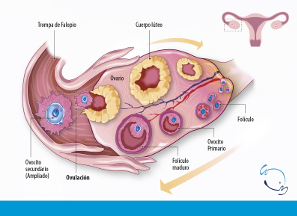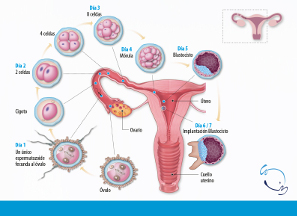Ovulation and fertility calculator
Prepare your pregnancy by taking folic acid before conception
With our ovulation calculator, you can find out when your eggs are ready to be fertilised. Take advantage of your fertile days to make your dream of getting pregnant come true. The days before the ovulation starts can also be helpful: as a spermatozoon can live between 24 and 48 hours inside the uterus. That means it is possible to get pregnant by having intercourse at that time, which is known by gynaecologists as preovulatory period. This is your fertile window, and it can last about two days. We encourage you to design your own fertility calendar with our woman's fertile day calculator.
How the ovulation calculator works
Calculating the date of your ovulation is basic for getting pregnant. Here is the ovulation calculator that will let you know which are your fertile days – the dates when, if you have sex, you have more chances of getting pregnant.
Using the ovulation calculator is very simple: just write down the first day of your last period, indicate how often you usually get your period (for example, every 29 days), and how many days approximately you have your period (for example 5 days, or 6 days...). With the result you will know, more or less, the day that your ovulation will occur, the days that your "fertile window" is at its peak and when your next period will come, and you can calculate this for several months. If your period is regular, you can create your own fertility calendar.
What is ovulation? Determine your fertile days
Ovulation, as Dr César Lizán, medical director of Clínicas Eva, explains, "is the moment when the egg is already mature and leaves the ovary towards the fallopian tubes, ready to meet the spermatozoa so fertilisation can take place”.
As a general rule, "ovulation occurs in the middle of the cycle, usually around day 14 in a regular 28-day menstrual cycle", adds Dr Lizán. But not all women have such regular cycles. Some have their periods every 25 days and others every 35 days, in which case calculating the ovulation days is more complicated.
Ovulation with short or long menstrual cycles
“When women have shorter or longer cycles, the most constant phase is the luteal phase, which corresponds to the second half of the cycle. This means that in women who have cycles of about 40 days, ovulation would occur around day 26. Similarly, if a woman has cycles of 22 days, her ovulation should occur around day 8 of the cycle," says Dr César Lizán.
What if my menstrual cycles are irregular?
There are also women who have very irregular cycles, that is, with months when they completely miss their period. This is the case of women who have polycystic ovary syndrome (PCOS). These women may suffer from what is known as anovulation [lack of ovulation], which is an obvious cause of difficulty in conceiving," says Dr Lizán. These cases require appropriate gynaecological treatment. For these women, it is more difficult to pinpoint their fertile days.
How does ovulation occur?
Within the female ovaries there are hundreds of thousands of follicles, which in turn house immature oocytes or eggs. During each menstrual cycle, one (or two) of these eggs matures due to hormones. This is how it works: at the beginning of the menstrual cycle, during the follicular phase, the female body starts producing a follicle-stimulating hormone. Its purpose is to stimulate the follicles that the woman’s body selects.
So a few will start to grow, until the woman’s body decides which of the follicles should continue to develop. It’s usually the one with the healthiest egg – the one with the best genes (that's why, as women become older, the chances of having a baby with chromosomal problems increase).
These follicles, in turn, begin to produce another hormone, oestrogen. Its function is to thicken the uterine lining, the endometrium, so that if pregnancy occurs, the embryo can implant itself in it. When the oestrogen reaches a certain level, it triggers a surge in luteinising hormone, which will cause the mature egg to be released from the follicle and go to the fallopian tubes, waiting for a spermatozoon to fertilise it.
Design your fertility calendar
Some women experience symptoms of ovulation: “the cervical mucus becomes more abundant with a more slippery consistency, there may be pain or mild cramps in the lower abdomen and menstrual spotting”, explains Dr Lizán. But this is not common. That’s why it is so important to have an ovulation calculator like the one you have here, which allows you to calculate your best days for conception and design a suitable fertility calendar.
To do this, it is very useful to write down in a notebook the days of ovulation, your symptoms, and when and how long you have your period for several months. This will help you understand how your body works and how to interpret the "fertility signals" your body sends out.
Discover your fertile window and keep calm
Every woman who wants to have a child looks for the fertile window of her cycle. Ideally, even if you know what your fertile days (the fertile window) are each month, sexual relations should take place around those dates in a relaxed way. We know that the less stress a couple suffers, the more likely they are to successfully take advantage of the window of fertility.
A woman’s fertile days, a great little miracle
Ovulation does not last long – it happens only for a couple days a month. As the medical director of Clinicas Eva explains, we must take into account that "the oocyte is a very delicate cell and its fertile life lasts between 12 and 24 hours". In other words, the time it has to meet the sperm is very short. Spermatozoa, on the other hand, "live" longer in the female reproductive system.
You have about two fertile days per cycle
“Spermatozoa maintain their fertile potential for a little longer than oocytes, about 72 hours. Therefore, combining the survival times of both gametes, we get an idea of the 'window of opportunity to get pregnant' that can last roughly a couple of days", explains Dr César Lizán.
The couple are recommended to have sexual relations during this period – the woman’s fertile days. However, attempts to count when they are going to fall can often "fail". "It is true that doctors rely heavily on the knowledge of proven studies and sometimes we have isolated cases that present us with unusual situations that can be difficult to explain with scientific theory," concludes Dr Lizán.
Fertility: ovulation days, before and after
The periovulation days, as they are known, are therefore also fertile days. As we have already said, we are talking about the days before and after ovulation.
It’s an interesting period for couples who are trying to conceive. Sometimes there are even cycles with early ovulation that bring forward the woman's "fertility window" by a few days.
That is why we can find cases (very few) of couples who have managed to conceive by having sex on the last day of the menstrual cycle, a period with very little chance of pregnancy. There can also be unexpected ovulation during the post-partum or quarantine period, before having the first period after giving birth.
The last phase of this whole process is the fertilisation of the oocyte and implantation in the woman's uterine cavity. One-third of pregnant women notice a small amount of spotting – implantation bleeding – which can sometimes be mistaken for a short, superficial period.









